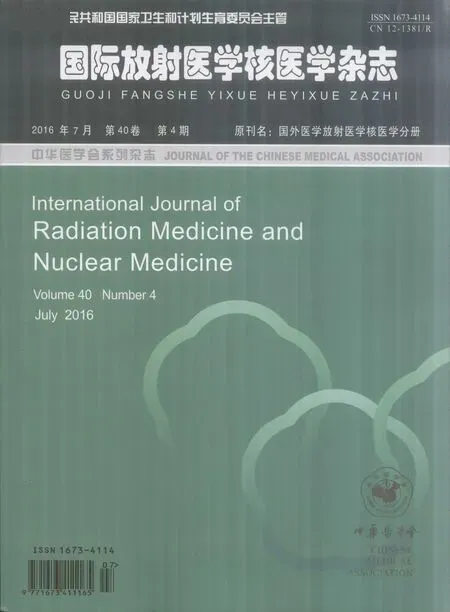低辐射剂量冠状动脉成像的研究进展
2016-03-09刘淑蓉孙凯
刘淑蓉 孙凯
014040,内蒙古医科大学包头市中心医院影像科
低辐射剂量冠状动脉成像的研究进展
刘淑蓉 孙凯
014040,内蒙古医科大学包头市中心医院影像科
冠状动脉CT成像(CCTA)已成为一种准确率较高的评价冠状动脉解剖形态的无创手段,但是检查产生的高剂量辐射越来越受到人们的普遍关注。如何在尽可能降低辐射剂量的同时保证诊断质量已成为CCTA的研究热点。笔者就该方面近年的研究进展做一综述。
冠状血管;体层摄影术,X线计算机;低辐射剂量
Fund programs:National Natural Science Foundation of China(81560286);The Inner Mongolia Autonomous Region Health and Family Planning Commission(201302124)
近年来,冠状动脉CT成像(coronary computed tomography angiography,CCTA)已成为一种准确率较高的评价冠状动脉形态的无创手段[1-2],但较高的辐射剂量是限制其广泛应用的主要因素,如何在尽可能降低辐射剂量的同时又能保证图像诊断质量已成为CCTA的研究热点[3-7]。降低CCTA辐射剂量的主要方法有降低管电压、降低管电流、迭代重建技术、前瞻性大螺距扫描、精确扫描范围等。笔者就以上各方法逐一进行综述。
1 降低管电压
辐射剂量一般与管电压的n(一般为2或3)次幂成正比,所以管电压对辐射剂量有较大影响。研究表明[8-9],使用低千伏的管电压技术不仅可以更多地降低辐射剂量,还可以提供更好的图像对比噪声比和较佳的低密度分辨率,有助于微小病灶的显示。Lee等[8]将53例患者随机分为3组,分别为前瞻性心电门控CCTA(prospective electrocardiogram triggeringCCTA,P-CCTA)100kV组、120kV组和回顾性心电门控CCTA(retrospective electrocardiogram gating CCTA,R-CCTA)120 kV组。P-CCTA 100 kV组有效剂量当量为(3.3±0.4)mSv,低于R-CCTA组的(6.7±1.0)mSv,差异有统计学意义(P<0.001),P-CCTA120kV组有效剂量当量为(4.6±1.2)mSv,结果表明在保证图像质量的同时降低管电压可以降低辐射剂量。Labounty等[9]将208名(体重指数<25kg/m2)无冠状动脉疾病病史的受试者分为80 kV组(n=103)和100 kV组(n=105)进行比较,80 kV组辐射剂量下降47%,图像质量提高27%[(756±157)HU vs.(594±105)HU,P<0.001];对比剂用量增加 25%[(890±156)HU vs.(709±108)HU,P<0.001];信噪比降低15%(15±5 vs.17±5,P<0.001);对比信噪比降低16%(17±6 vs.21±5,P<0.001);图像质量的差异无统计学意义(99%vs.99%,P=0.99),提示降低管电压的同时可增加对比剂的用量。
2 降低管电流
管电流量代表X射线的量。研究表明,适当降低管电流可以用最低的辐射剂量获得最佳的图像质量,同时减少序列扫描和螺旋扫描中扫描部位所接受的射线剂量[6,10]。Shen等[6]将294例患者分为固定管电流组(组1,n=102)和调整管电流组(n= 192),调整管电流组又分为采用滤波反向投影算法组(组2,n=99)和采用迭代重建组(组3,n=93),组1的图像噪声为28.41~36.49 HU,组2为34.17~35.08 HU,组3为34.34~35.03 HU,与组1(均值11.5 mSv)相比,组2(均值9.9 mSv)和组3(均值6.8 mSv)的辐射剂量分别下降将近14%和41%,提示降低管电流可降低辐射剂量。心电门控调制管电流曝光技术可根据心动周期在预选时相范围内采用高毫安输出,其余时相则为低毫安,可以降低辐射剂量。May等[10]将56例患者分为心电门控电流调整组和固定管电流组,有效剂量当量分别为(7.1±2.1)mSv/100 mAs(心电门控管电流调整)和(12.5±5.3)mSv/100 mAs(固定管电流)(P<0.001),与固定管电流组相比,心电门控管电流调整可将辐射剂量降低至52%。
3 迭代重建技术
迭代算法比传统的滤波反投影算法能够更好地提高图像的信噪比和消除或抑制图像伪影。Ebersberger等[11]运用双源CT对37例置入支架患者进行研究,分别采用迭代重建技术和滤波反投影算法(filtered back projection,FBP),两者相比,迭代重建技术的支架内信噪比明显改善(18.2±6.9 vs.14.3±6.7,P<0.01);图像质量没有明显差别(3.5±1.0 vs. 3.7±1.1,P>0.01);迭代重建技术有效剂量当量从(8.7±5.2)mSv降低到(4.3±2.6)mSv,表明迭代重建技术明显优于FBP。Takx等[12]选取20例患者,分为两组:FBP投影算法组(组1)和低剂量迭代重建算法组(组2),其中组1又分标准FBP投影算法组(组1a,100%管电流,70%RR间期)和低剂量组(组1b,20%管电流,20%~90%RR间期,80%重建)。与组1b相比,组2的图像噪声降低了22%(P<0.0001~0.0033),提示运用迭代重建算法可降低图像噪声。Maffei等[13]研究结果表明,160例患者[平均心率为(64.3±11.9)次/min]采用迭代重建算法有效剂量当量均值为(7.2±2.1)mSv,提示采用迭代重建算法能够降低辐射剂量。
4 前瞻性大螺距扫描
前瞻性心电触发大螺距扫描是Flash双源CT所特有的一种新型螺旋采集技术。普通螺旋CT需要低螺距(<1.5)以保证容积采集无间隙,但身体同一部位在连续的几次机架旋转中持续接受射线辐射,从而增加了辐射剂量。64层双源CT拥有两套球管和相应的两套探测器系统,第二套探测器的数据可以填补第一套探测器的间隙,其拥有更宽的探测器(38.4 mm)和更快的旋转速度,实现了大螺距(3.4)无间隙扫描,可在一个心动周期(0.25 s)内完成全心扫描,避免多个心动周期采集时重叠扫描,从而降低了辐射剂量。Leschka等[14]对45例患者进行大螺距扫描研究,采取图像处理中无需特异评价的冠脉区段为积极意义图像,以冠状动脉造影结果为参考标准,冠脉狭窄灵敏度、特异度、阳性预测值、阴性预测值分别为94%、96%、80%、99%(每个节段评价);100%、91%、88%、100%(每例患者评价);97.5%、91.2%、61.4%、99.6%(每个血管评价);有效剂量当量为(0.9±0.1)mSv,提示采用大螺距扫描可以降低辐射剂量。Sun等[15]研究结果表明,20% RR间期~30%RR间期大螺距扫描和回顾性心电门控有效剂量当量分别为(1.0±0.16)mSv和(7.1±1.05)mSv(P=0.001),说明前瞻性大螺距扫描是降低辐射剂量的有效方法。Wolf等[16]研究12例患者冠状动脉支架不同放置位置的模型,大螺距组(3.4)与低螺距组(0.2)相比,容积CT剂量指数分别为5.17 mGy和55.97 mGy,有效剂量当量可降低10倍,提示采用大螺距扫描可降低辐射剂量。Sun等[17]对82例患者采用前瞻性大螺距扫描模式进行冠状动脉和颈部血管联合扫描,有效剂量当量为(1.42±0.44)mSv[范围(0.88~3.35)mSv],提示前瞻性大螺距扫描模式可以降低辐射剂量。Gordic等[18]研究第三代双源CT CCTA大螺距扫描模式其有效剂量当量为(0.4±0.1)mSv,心脏扫描时间(0.17±0.02)s,也提示第三代双源CT大螺距扫描模式可以降低辐射剂量。
5 精确扫描范围
CCTA应根据冠状动脉钙化积分扫描图像来精确所需的冠状动脉走行范围并确定扫描层数,避免因范围设置不当而产生不必要的辐射剂量,但同时应防止吸气幅度不一致导致心脏位置不同而遗漏病变图像。Zimmermann等[19]对45例可能患有冠状动脉疾病的患者按Z轴范围调整扫描长度为14 cm(2例患者)、12.8 cm(3例患者)、12 cm(40例患者)和16 cm(45例患者,必须执行的扫描长度),基于个人心脏大小(9.6±1.1)cm,确定CCTA扫描范围是(12.1±0.5)cm。根据低剂量冠状动脉钙化积分扫描调整的总的有效辐射剂量小于相应16 cm组(无低剂量的冠状动脉钙化积分扫描)[(8.5±4.7)mSv vs.(9.1±6.0)mSv,P=0.006]。精确扫描范围对降低冠脉成像的辐射剂量是有必要的。
6 小结与展望
CCTA辐射剂量的优化是综合性的,结合多种低剂量技术的综合应用,优化扫描参数,降低患者的辐射剂量以达到放射医学所追求的低剂量原则。目前国内外研究的热点为双低,即低辐射剂量和低对比剂用量。第三代双源CT大螺距低辐射剂量扫描是一种全新扫描模式,可以进一步显著降低对比剂用量。然而对比剂的使用参数目前尚未见明确定论[20-22],因此可进一步探讨对比剂用量。
利益冲突 本研究由署名作者按以下贡献声明独立开展,不涉及任何利益冲突。
作者贡献声明 刘淑蓉负责论文撰写;孙凯负责提出命题、论文审阅。
[1]Alkadhi H,Stolzmann P,Desbiolles L,et al.Low-dose,128-slice, dual-source CT coronary angiography:accuracy and radiation dose of the high-pitch and the step-and-shoot mode[J].Heart,2010,96(12):933-938.DOI:10.1136/hrt.2009.189100.
[2]Li H,Jin D,Qiao F,et al.Relationship between the Self-Rating Anxiety Scale score and the success rate of 64-slice computed tomography coronary angiography[J].Int J Psychiatry Med,2016,51(1):47-55.DOI:10.1177/0091217415621265.
[3]Li Q,Li P,Su Z,et al.Effect of a novel motion correction algorithm(SSF)on the image quality of coronary CTA with intermediate heart rates:segment-based and vessel-based analyses[J].Eur J Radiol, 2014,83(11):2024-2032.DOI:10.1016/j.ejrad.2014.08.002.
[4]Wang Q,Qin J,He B,et al.Computed tomography coronary angiography with a consistent dose below 2 mSv using double prospectively ECG-triggered high-pitch spiral acquisition in patients with atrial fibrillation:initial experience[J].Int J Cardiovasc Imaging,2013,29(6):1341-1349.DOI:10.1007/s10554-013-0203-0.
[5]Ulimoen GR,Ofstad AP,Endresen K,et al.Low-dose CT coronary angiography for assessment of coronary artery disease in patients with type 2 diabetes-a cross-sectional study[J].BMC Cardiovasc Disord,2015,15:147-153.DOI:10.1186/s12872-015-0143-9.
[6]Shen JL,Du XY,Guo DD,et al.Noise-based tube current reduction method with iterative reconstruction for reduction of radiation exposure in coronary CT angiography[J].Eur J Radiol,2013,82(2):349-355.DOI:10.1016/j.ejrad.2012.10.008.
[7]Einstein AJ,Wolff SD,Manheimer ED,et al.Comparison of image quality and radiation dose of coronary computed tomographic angiography between conventional helical scanning and a strategy incorporating sequential scanning[J].Am J Cardiol,2009,104(10):1343-1350.DOI:10.1016/j.amjcard.2009.07.003.
[8]Lee JW,Kim CW,Lee HC,et al.High-definition computed tomography for coronary artery stents:image quality and radiation doses for low voltage(100 kVp)and standard voltage(120 kVp)ECG-triggered scanning[J].Int J Cardiovasc Imaging,2015,31(Suppl 1):S39-49.DOI:10.1007/s10554-015-0686-y.
[9]Labounty TM,Leipsic J,Poulter R,et al.Coronary CT angiography of patients with a normal body mass index using 80 kVp versus 100 kVp:a prospective,multicenter,multivendor randomized trial[J]. AJR Am J Roentgenol,2011,197(5):W860-W867.DOI:10. 2214/AJR.11.6787.
[10]May MS,Deak P,Kuettner A,et al.Radiation dose considerations by intra-individual Monte Carlo simulations in dual source spiral coronary computed tomography angiography with electrocardiogram-triggered tube current modulation and adaptive pitch[J].Eur Radiol,2012,22(3):569-578.DOI:10.1007/s00330-011-2300-6.
[11]Ebersberger U,Tricarico F,Schoepf UJ,et al.CT evaluation of coronary artery stents with iterative image reconstruction:improvements in image quality and potential for radiation dose reduction[J]. Eur Radiol,2013,23(1):125-132.DOI:10.1007/s00330-012-2580-5.
[12]Takx RA,Schoepf UJ,Moscariello A,et al.Coronary CT angiography:comparison of a novel iterative reconstruction with filtered back projection for reconstruction of low-dose CT-Initial experience [J].Eur J Radiol,2013,82(2):275-280.DOI:10.1016/j.ejrad. 2012.10.021.
[13]Maffei E,Martini C,Rossi A,et al.Diagnostic accuracy of secondgeneration dual-source computed tomography coronary angiography with iterative reconstructions:a real-world experience[J].Radiol Med,2012,117(5):725-738.DOI:10.1007/s11547-011-0754-x.
[14]Leschka S,Stolzmann P,Desbiolles L,et al.Diagnostic accuracy of high-pitch dual-source CT for the assessment of coronary stenoses:first experience[J].Eur Radiol,2009,19(12):2896-2903.DOI:10.1007/s00330-009-1618-9.
[15]Sun K,Han RJ,Ma LJ,et al.Prospectively electrocardiogram-gated high-pitch spiral acquisition mode dual-source CT coronary angiography in patients with high heart rates:comparison with retrospective electrocardiogram-gated spiral acquisition mode[J].Korean J Radiol,2012,13(6):684-693.DOI:10.3348/kjr.2012.13.6. 684.
[16]Wolf F,Leschka S,Loewe C,et al.Coronary artery stent imaging with 128-slice dual-source CT using high-pitch spiral acquisition in a cardiac phantom:comparison with the sequential and low-pitch spiral mode[J].Eur Radiol,2010,20(9):2084-2091.DOI:10. 1007/s00330-010-1792-9.
[17]Sun K,Li K,Han R,et al.Evaluation of high-pitch dual-source CT angiography for evaluation of coronary and carotid-cerebrovascular arteries[J].Eur J Radiol,2015,84(3):398-406.DOI:10.1016/j. ejrad.2014.11.009.
[18]Gordic S,Husarik DB,Desbiolles L,et al.High-pitch coronary CT angiography with third Generation dual-source CT:limits of heart rate[J].Int J Cardiovasc Imaging,2014,30(6):1173-1179.DOI:10.1007/s10554-014-0445-5.
[19]Zimmermann E,Dewey M.Whole-heart 320-row computed tomography:reduction of radiation dose via prior coronary Calcium scanning[J].RoFo,2011,183(1):54-59.DOI:10.1055/s-0029-1245629.
[20]Formosa A,Santos DM,Marcuzzi D,et al.Low contrast dose catheter-directed CT angiography(CCTA)[J].Cardiovasc Intervent Radiol,2016,39(4):606-610.DOI:10.1007/s00270-015-1232-y.
[21]Yin WH,Lu B,Gao JB,et al.Effect of reduced x-ray tube voltage, low Iodine concentration contrast medium,and sinogram-affirmed iterative reconstruction on image quality and radiation dose at coronary CT angiography:results of the prospective multicenter REALISE trial[J].J Cardiovasc Comput Tomogr,2015,9(3):215-224.DOI:10.1016/j.jcct.2015.01.010.
[22]Komatsu S,Kamata T,Imai A,et al.Coronary computed tomography angiography using ultra-low-dose contrast media:radiation dose and image quality[J].Int J Cardiovasc Imaging,2013,29(6):1335-1340.DOI:10.1007/s10554-013-0201-2.
The advances of low radiation dose coronary computed tomography angiography imaging
Liu Shurong,Sun Kai
Department of Image,Baotou Central Hospital of Inner Mongolia Medical University,Baotou 014040,China
Sun Kai,Email:Henrysk@163.com
Coronary computed tomography angiography(CCTA)has become a noninvasive method with high accuracy for evaluation of the coronary artery morphology,meanwhile,people have been paying more attention to the high radiation dose delivered during the imaging procedure.In recent years,it has been a hot research topic of keeping the radiation dose as low as possible with no sacrifice of the imaging quality.This article summarized and explored the advances of methods in reducing radiation dose for CCTA.
Coronary vessels;Tomography,X-ray computed;Low radiation dose
孙凯,Email:Henrysk@163.com
10.3760/cma.j.issn.1673-4114.2016.04.011
国家自然科学基金(81560286);内蒙古自治区卫生和计划生育委员会项目(201302124)
2016-03-20)
